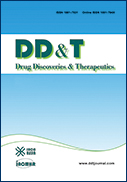Volume 6, Issue 4
Displaying 1-8 of 8 articles from this issue
- |<
- <
- 1
- >
- >|
Reviews
-
2012Volume 6Issue 4 Pages 169-177
Published: August 31, 2012
Released on J-STAGE: June 13, 2014
Download PDF (610K) -
2012Volume 6Issue 4 Pages 178-193
Published: August 31, 2012
Released on J-STAGE: June 13, 2014
Download PDF (565K)
Brief Report
-
2012Volume 6Issue 4 Pages 194-197
Published: August 31, 2012
Released on J-STAGE: June 13, 2014
Download PDF (270K)
Original Articles
-
2012Volume 6Issue 4 Pages 198-204
Published: August 31, 2012
Released on J-STAGE: June 13, 2014
Download PDF (295K) -
2012Volume 6Issue 4 Pages 205-211
Published: August 31, 2012
Released on J-STAGE: June 13, 2014
Download PDF (241K) -
Antimicrobial screening of some Egyptian plants and active flavones from Lagerstroemia indica leaves2012Volume 6Issue 4 Pages 212-217
Published: August 31, 2012
Released on J-STAGE: June 13, 2014
Download PDF (250K) -
2012Volume 6Issue 4 Pages 218-225
Published: August 31, 2012
Released on J-STAGE: June 13, 2014
Download PDF (314K)
Commentary
-
2012Volume 6Issue 4 Pages 226-229
Published: August 31, 2012
Released on J-STAGE: June 13, 2014
Download PDF (226K)
- |<
- <
- 1
- >
- >|
